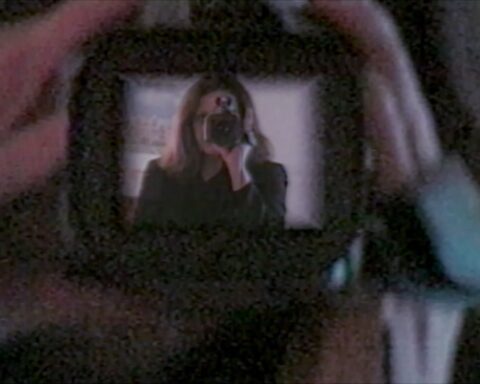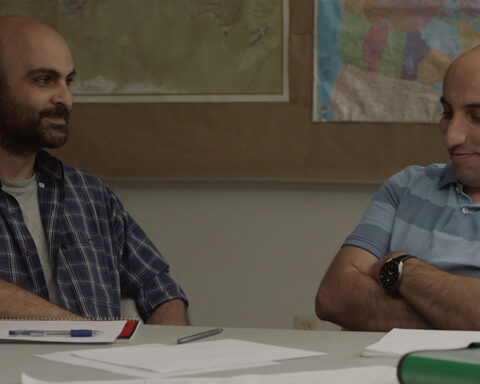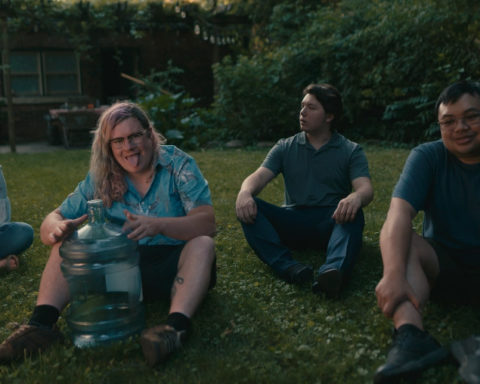For the last two decades, artist Jorge Lozano has been prolific in his production of films and videos notable for their social and political engagement, a strong sense of formal invention and aesthetic rigour. Out of a vast and varied body of work, Lozano’s portraits stand out, primarily for the stories that his subjects share and also for the way in which Lozano presents their accounts. The portraits range from single-channel videos that can be screened in conventional cinemas or on individual monitors to multifaceted installations destined for galleries or alternative exhibition spaces. Lozano refers to these works as docu-installations, as they serve a documentary function while exploring new forms for presenting information and telling stories.
The mass media often resorts to generalisation and euphemism (as in the current trend to refer to refugees as migrants) when reporting social and political strife, and rarely has the time or space to allow more than just a sound bite from people living in difficult circumstances. In contrast, Lozano’s portraits create a form for the stories and insights of the people from whom we seldom hear. Several of his most powerful works document people who are coping with violence and the various forms it can take: the institutional racism of the Toronto police and the difficulties of at-risk youth in Watch My Back the ongoing effects of civil war in Colombia in Underscore ( _ ) Subguión and MOVING STILL _ still life and the brutal effects that illness can have on the human body in Death Match.
Perhaps his most complex work to date, MOVING STILL _ still life, is an eight channel docu-installation that was inspired by the people he met while working as an educator and facilitator of self-representation workshops for at-risk youth in Colombia, Panama and Toronto. The installation depicts the harsh reality of daily life in Siloé, a suburb of Cali, Colombia that is plagued with chronic violence. The community is a microcosm of the protracted civil strife afflicting this South American country. That conflict, which is sometimes described as a “low-intensity” war between Government forces, right-wing paramilitary groups and leftist guerilla fighters (FARC), has cost tens of thousands of lives, displacing over six million people internally and creating nearly 400,000 refugees over the past 50 years.
MOVING STILL _ still life consists of a series of seven interviews moving across the screens of the installation as the remaining frames become a contextualizing chorus of images, which refer both directly and obliquely to the individuals being interviewed and the stories they tell. By creating a proliferation of points of view Lozano moves away from the usual form of the documentary that illustrates a singular argument or opinion and allows the viewer the freedom to navigate the work in his or her own way. The addition of excerpts from movies made in workshops he’s led layers fact and fiction, adding other voices to the work. Each section of the work has a distinctive internal structure, using the eight screens to create different effects. The introduction traverses the spectacular Colombian landscape from mountain streams to the coast before arriving in the urban centres and bustling city streets.
The first interview takes place in a prison in Cartagena with a woman identified as Remedios A. We learn she is there for her involvement with a paramilitary group that “cleansed” her neighbourhood of the gangs that had been active there. She has no remorse for her crime, believing her actions necessary to bringing peace and quiet to the area. As she speaks from one screen, the other seven contain images of the prison grounds and colourful drawings and paintings made by the inmates. There is a stark contrast between the innocent qualities of the artwork and the brutality relayed in the interview.
In the next section we meet Botas, a former gang member and survivor of an assassination attempt, who is interviewed by Edward Blackfire, one of the participants in Lozano’s workshops. The rapport that Blackfire, who is a cultural worker in the local community and knows the young men he interviews, and Botas share imbues a serious topic with a light touch and an openness that might not have been possible with Lozano behind the lens. Botas reveals he was shot seven times, and the eight screens each provide a slightly different perspective as he shows his scars to Blackfire’s camera. Eschewing violence, Blackfire remains diplomatic in the next section as he interviews a young assassin, Maikel, at home while his mother adds supportive comments from her perch on the bed where his weapons are displayed. Unlike Botas, who has left his violent past behind and speaks about the need for education and arts programmes, Maikel can’t imagine a future without guns; for him, disarmament means certain death. In support of his belief, Maikel refers to the film Our Lady of the Assassins, in which a character is killed after repenting and discarding his weapon. For Maikel, the fiction film, the story of a young killer not unlike himself, rings true.
Throughout MOVING STILL _ still life, Lozano manipulates the images we see in different ways, showing extreme close-ups on one screen of what might be a medium shot in another, using blank white or black screens to emphasize or focus our attention, and slowing down the footage to suggest how time slows down in moments of trauma. In some sections, he also moves the screen with the narration across the bank of monitors keeping us actively engaged as our attention shifts to the related images. Against this complex and multifaceted backdrop it is the voices of the Colombians that stand out, whether accepting of or resistant to their circumstances: their intelligence and candour contradict the clichés that so often are used to describe the country and its citizens.
Lozano’s various approaches to video portraiture are also apparent in three earlier works; each of which can be understood as precursors to MOVING STILL _ still life.
Underscore ( _ ) Subguión is Lozano’s twin-screen video portrait of a Colombian political activist living in exile in Canada. The unnamed man tells his story of the assassination attempt that forced him to go into hiding and then flee his home. The title refers to the gaps in the subtitles—indicated with an underscore symbol—where the names of people and places along with other information that might identify the man have been removed for the protection of him and his family. These gaps also correspond to the interruptions in the audio where the Spanish words have been edited out.
The man, now an exile, recounts how he survived two successive assassination attempts, the second of which resulted in multiple bullet wounds and a near-fatal car accident when he was shot during a high-speed chase. Similar to Botas describing his bullet wounds, this survivor gives a precise account of the extent of his injuries, his treatment, recovery and escape. In the left side of the screen, the man’s head and sometimes his shoulders are tightly framed and slightly abstracted by a black-and-white half-tone filter. His voice is also disguised. Toward the latter part of the video, we learn that as a result of his injuries and the passage of time, the man’s physical appearance has been significantly altered and it is his voice that remains his most distinctive feature. On the right screen, we see a near-duplicate image in extreme close-up. It’s a complete abstraction that is still rhythmically linked to the view in the other screen as it moves and shifts with the subject as the man gives his account. The colour palette on the right, predominantly red and black, is suggestive of the bloodshed in his story. Purposeful interruptions, distortions and abstractions in this video, rather than being a distraction, focus the attention of the viewer while suggesting the oppressive political violence which made this man an exile.
Inspired by self-representation workshops Lozano conducted in Toronto and made in close collaboration with his subjects, the four channels in Watch My Back each contain a portrait of a different Toronto youth. Their accounts of time spent in prison and how they came to be there are transcribed in subtitles at the bottom of the screens. The youths are positioned with their backs to the camera, shirtless, shot from the waist up. This pose allows them their privacy and a degree of anonymity while exposing their vulnerability. Each back is superimposed over a moving background that represents an aspect of his or her existence. From the interior rooms of one youth’s home to the exterior of the housing project of another, an underpass replete with graffiti and a close-up of the tattoos that one youth has collected over the years, the moving background images create a destabilizing effect which underlines the precariousness of the situations from which they are all trying to emerge. While their stories are different, each youth lived in circumstances that, along with their ethnicity and socio-economic status, made them targets for the police. The youths’ astute reflections belie the stereotypes to which they are constantly subjected and encourage the audience to reflect on our own malfunctioning criminal justice system that allows the police force to behave comparably to the “gangs” it aims to disband.
Death Match is an unforgettable portrait of Lozano’s young cousin Victor. More personal than political, its structure riffs off a public service announcement, as Victor’s first-person descriptions of his torturous medical condition are interspersed with title cards defining the relevant medical terms. As Victor explains his condition and treatment, the camera examines his body. Close-ups are used as he describes the particulars of where catheters are inserted, shows us where veins have been closed, and displays the scars of multiple operations. When Victor speaks more generally about his experience he is framed at a distance with a long shot. We learn that of 72 people in the group that Victor began treatment with, he is one of two still alive. Victor’s strength and courage in the face of constant suffering and imminent death are heart-rending, and the climactic chords of his heavy metal band Death Match serve as a testament to his spirit.
From his single-channel works to his docu-installations Lozano builds unique and compelling structures to house his portraits, giving them a form that assures they stay in our memory long after they are viewed. From the streets of Toronto to the hillsides of Siloé, he serves as a generous and intelligent witness, recording the accounts of remarkable individuals who remind us of the many voices that remain unheard.
MOVING STILL _ still life premiered at the Ryerson Image Centre in 2015.
Select films by Jorge Lozano screen at TIFF Bell Lightbox on June 21 and Watch My Back screens as the centrepiece film of Pleasure Dome’s Cooking with Jorge on June 25.











